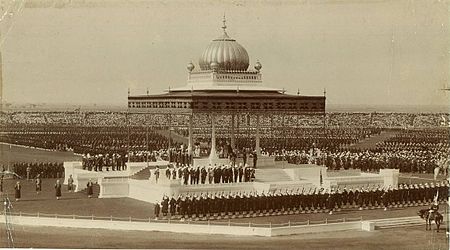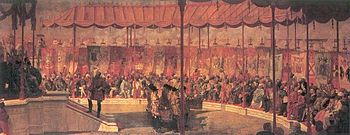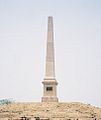- Delhi Durbar
-
The Delhi Durbar (Hindi: दिल्ली दरबार, Urdu: دلّی دُربار), meaning "Court of Delhi", was a mass assembly at Coronation Park, Delhi, India, to mark the coronation of a King and Queen of the United Kingdom. Also known as the Imperial Durbar, it was held three times, in 1877, 1903, and 1911, at the height of the British Empire. The 1911 Durbar was the only one attended by the sovereign, who was George V. The term was derived from common Mughal term durbar.
Contents
Durbar of 1877
Called the "Proclamation Durbar", the Durbar of 1877 was held beginning on 1 January 1877 to designate the coronation and proclaim Queen Victoria as Empress of India. The 1877 Durbar was largely an official event and not a popular occasion with mass appeal like 1903 and 1911. It was attended by the 1st Earl of Lytton - Viceroy of India, maharajas, nawabs and intellectuals. This was the culmination of transfer of control of much of India from the British East India Company to the The Crown.
The Durbar was the beginning of a great transformation for India where the campaign for a free India was formally launched.[1]
Inside Victoria Memorial in Kolkata is an inscription taken from the Message of Queen Victoria presented at the 1877 Durbar to the people of India:
"We trust that the present occasion
may tend to unite in bonds of close
affection ourselves and our subjects;
that from the highest to the humblest,
all may feel that under our rule the
great principles of liberty, equity,
and justice are secured to them; and
to promote their happiness, to add to
their prosperity, and advance their
welfare, are the ever present aims and
objects of our Empire."A medal to commemorate the Proclamation of the Queen as Empress of India was struck and distributed to honoured guests.[2]
Ramanath Tagore was made a Maharaja by Lord Lytton, viceroy of India.[3]It was at this glittering durbar that a man in "homespun spotless white khadi" rose to read a citation on behalf of the Pune Sarvajanik Sabha. Ganesh Vasudeo Joshi put forth a demand couched in very polite language:
"We beg of Her Majesty to grant to India the same political and social status as is enjoyed by her British subjects." With this demand, it can be said that the campaign for a free India was formally launched.[4]
Durbar of 1903
The durbar was held to celebrate the coronation of King Edward VII and Queen Alexandra as Emperor and Empress of India.
The two full weeks of festivities were devised in meticulous detail by Lord Curzon. It was a dazzling display of pomp, power and split second timing. Neither the earlier Delhi Durbar of 1877, nor the later Durbar held there in 1911, could match the pagentry of Lord Curzon’s 1903 festivities. In a few short months at the end of 1902, a deserted plain was transformed into an elaborate tented city, complete with temporary light railway to bring crowds of spectators out from Delhi, a post office with its own stamp, telephone and telegraphic facilities, a variety of stores, a Police force with specially designed uniform, hospital, magistrate’s court and complex sanitation, drainage and electric light installations. Souvenir guide books were sold and maps of the camping ground distributed. Marketing opportunities were craftily exploited. Special medals were struck, firework displays, exhibitions and glamorous dances held.
Edward VII, to Curzon’s disappointment, did not attend but sent his brother, the Duke of Connaught who arrived with a mass of dignitaries by train from Bombay just as Curzon and his government came in the other direction from Calcutta. The assembly awaiting them displayed possibly the greatest collection of jewels to be seen in one place. Each of the Indian princes was adorned with the most spectacular of his gems from the collections of centuries. Maharajahs came with great retinues from all over India, many of them meeting for the first time while the massed ranks of the Indian armies, under their Commander-in-Chief Lord Kitchener, paraded, played their bands and restrained the crowds of common people.[5]
On the first day, the Curzons entered the area of festivities, together with the maharajahs, riding on elephants, some with huge gold candelabras stuck on their tusks. The durbar ceremony itself fell on New Year's Day and was followed by days of polo and other sports, dinners, balls, military reviews, bands, and exhibitions. The world’s press dispatched their best journalists, artists and photographers to cover proceedings. The popularity of movie footage of the event, shown in makeshift cinemas throughout India, is often credited with having launched the country’s early film industry.[6][7]
The Aga Khan III used this occasion to speak out for the expansion of all types of educational facilities in India.[8]
The event culminated in a grand coronation ball attended only by the highest ranking guests, all reigned over by Lord Curzon and more so by the stunning Lady Curzon in her glittering jewels and regal peacock gown.[9]
Durbar of 1911
Held in December to commemorate the coronation in Britain a few months earlier of King George V and Queen Mary, and their proclamation as Emperor and Empress of India--and, without public forewarning, the shifting of India's capital from Calcutta to Delhi.
Practically every ruling prince, nobleman, landed gentry and other persons of note in India attended to pay obeisance to their sovereigns. The Sovereigns appeared in their Coronation robes, the King-Emperor wearing the Imperial Crown of India with eight arches, containing six thousand one hundred and seventy exquisitely cut diamonds, and covered with sapphires, emeralds and rubies, with a velvet and miniver cap all weighing 34.05 ounces (965 g). They then appeared at a darshan (a sight) at the jharoka (balcony window) of Red Fort, to receive half a million or more of the common people who had come to greet them.[10] A feature film of the coronation titled With Our King and Queen Through India (1912) – also known as The Durbar in Delhi – was filmed in the early color process Kinemacolor and released on 2 February 1912.[11]
A Delhi Herald of Arms Extraordinary and an Assistant Herald were appointed for the 1911 Durbar (Brigadier-General William Peyton and Captain the Hon. Malik Mohammed Umar Hayat Khan), but their duties were more ceremonial than heraldic.[12]
Practically every ruling prince, nobleman, landed gentry and other persons of note in India attended to pay obeisance to their sovereigns. The Sovereigns appeared in their Coronation robes, the King-Emperor wearing the Imperial Crown of India with eight arches, containing six thousand one hundred and seventy exquisitely cut diamonds, and covered with sapphires, emeralds and rubies, with a velvet and miniver cap all weighing 34.05 ounces (965 g). They then appeared at a darshan (a sight) at the jharoka (balcony window) of Red Fort, to receive half a million or more of the common people who had come to greet them.[10] A feature film of the coronation titled With Our King and Queen Through India (1912) – also known as The Durbar in Delhi – was filmed in the early color process Kinemacolor and released on 2 February 1912.[11]
A Delhi Herald of Arms Extraordinary and an Assistant Herald were appointed for the 1911 Durbar (Brigadier-General William Peyton and Captain the Hon. Malik Mohammed Umar Hayat Khan), but their duties were more ceremonial than heraldic.[12]
There is a magnificent tiara belonging to the present Queen called the Delhi Durbar Tiara. The necklace was presented to Queen Mary by the Maharanee of Patiala on behalf of the Ladies of India to mark the first visit to India by a British Queen-Empress. At the Queen’s suggestion, it was designed to match her other emerald jewellery created for the Delhi Durbar. In 1912 Garrards slightly altered the necklace, making the existing emerald pendant detachable and adding a second detachable diamond pendant. This is an 8.8 carats (1,800 mg) marquise diamond known as Cullinan VII, one of the nine numbered stones cut from the Cullinan Diamond. The necklace was inherited by the Queen in 1953[13] and was recently worn by the Duchess of Cornwall to a ball where she met the Norwegian Royal Family.
Twenty-six thousand eight hundred (26,800) Delhi Durbar Silver Medals of 1911 were awarded, mostly to men and officers of the British regiments. A small number were also struck in gold for award to Indian princely rulers and the highest ranking government officers.[14]
Today Coronation Park is a jealously guarded open space whose emptiness comes as a bit of a shock after the dense traffic and crowded shanty towns of northern Delhi’s urban sprawl. It is mostly overgrown, neglected and locked. The Park is sometimes used for big religious festivals and municipal conventions.[15]
No further Durbar
While Edward VIII abdicated in December 1936 before he had had any coronation, it was initially envisaged that his successor George VI would ultimately visit India and have his own Durbar. The Indian National Congress passed a motion weeks after his accession calling for a boycott of any such visit, and in February 1937 Communist MP Willie Gallacher decried expenditure on such festivities in a country of such poverty.[16] The King's Speech of October 1937 included "I am looking forward with interest and pleasure to the time when it will be possible for Me to visit My Indian Empire",[17] to the satisfaction of Sir Hugh O'Neill.[18] However, the onset of World War II and the movement towards Indian independence meant this visit never happened.
Gallery
-
Interior of the Victoria Memorial, Kolkata (the inscription is to the right of the statue).
-
Commemorative Obelisk at Coronation Park, Delhi, erected at the exact place where King George V and Queen Mary sat in 'Delhi Durbar' of 1911 while declaring the shifting of capital of British Raj from Calcutta to Delhi
-
Malik Umar Hayat Khan serving as Assistant Delhi Herald Extraordinary in 1911.
Further reading
- Army, Indian (1877). Soldiers' games : 'Imperial Assemblage'. Delhi, 3rd January, 1877. s. n.. http://www.archive.org/stream/soldiersgamesimp00delh#page/n0/mode/2up.
- Codell, Julie, ed. (2011). Power and Resistance: Photography and the Delhi Coronation Durbars. Ahmedabad: Mapin.
- Codell, Julie (2009), "Indian Crafts and Imperial Policy: Hybridity, Purification and Imperial Subjectivities," Material Cultures, 1740-1920: The Meanings and Pleasures of Collecting. Eds. A. Myzelev & J. Potvin. Aldershot: Ashgate, 149-70.
- Codell, Julie (2004), "Gentlemen connoisseurs and capitalists: Modern British Imperial Identity in the 1903 Delhi Durbar Exhibition of Indian Art," Cultural Identities and the Aesthetics of Britishness. Ed. D. Arnold. Manchester U P, 134-63.
- Fraser, Lovat (1903). At Delhi (An account of the Delhi Durbar, 1903). Bombay : Times of India Press and Thacker. http://www.archive.org/stream/atdelhifras00fras#page/n5/mode/2up.
- Hobbes, John Oliver (1903). Imperial India; letters from the East (Delhi Durbar). London : T.F. Unwin. http://www.archive.org/stream/imperialindialet00hobbiala#page/n7/mode/2up.
- Coronation Durbar Delhi 1911. Superintendent Government Press. 1911. http://www.archive.org/stream/coronationdurbar030742mbp#page/n5/mode/2up.
- Fortescue, J. W. (1912). Narrative of the visit to India of their majesties King George V and Queen Mary and of the coronation Durbar held at Delhi 12th December, 1911. London : Macmillan. http://www.archive.org/stream/narrativeofvisit00fortuoft#page/n7/mode/2up.
References
- ^ KESAVAN MUKUL (Sunday, May 29, 2005) "STORY OF THE CONGRESS - Three pivotal moments that shaped early nationalism in India", The Telegraph, Calcutta, retrieved 3/19/2007 nationalism
- ^ The Illustrated London News Jan, 20 - Feb. 17, (1877) retrieved 3/18/2007 medal
- ^ Cotton, H.E.A., Calcutta Old and New, 1909/1980, p596, General Printers and Publishers Pvt. Ltd.
- ^ The Delhi Durbar, Dimdima.com, magazine of Bharatiya Vidya Bhavan,free india
- ^ De Courcy Anne (2003) "The Viceroy's Daughters: The Lives of the Curzon Sisters", Harper Collins, 464 pages, ISBN 0-06-093557-X, 61 page Abstract(biography) retrieved from Google 3/14/2007
- ^ Holmes Richard, "Sahib: The British Soldier in India 1750-1914". HARPERCOLLINS. 571 pages.
- ^ Bottomore Stephen (Oct, 1995) "An amazing quarter mile of moving gold, gems and genealogy": filming India's 1902/03 Delhi Durbar, Historical Journal of Film, Radio and Television, includes extensive bibliography of the event, retrieved 3/18/2007 filming the Durbar
- ^ Sir Sultan Muhammad Shah Aga Khan (Dec. 4, 1911) Speeches of Aga Khan III, Inaugural Speech at the All India Muhammadan Educational Conference, Delhi (Full text) retrieved 3/18/2007 Aga Khan speech
- ^ Cory, Charlotte (2002) Sunday Times, December 29th, retrieved 3/14/2007 "The Delhi Durbar 1903 Revisited",1903 Durbar, extensive description
- ^ The Royal Ark, Royal and Ruling Houses of Africa, Asia, Oceania and the Americas royal jewels
- ^ Filming the Delhi Durbar 1911 filming
- ^ Cox, Noel, A New Zealand Heraldic Authority? in John Campbell-Kease (ed), Tribute to an Armorist: Essays for John Brooke-Little to mark the Golden Jubilee of The Coat of Arms, London, The Heraldry Society, 2000, p. 93 & p. 101: "Two heralds, with ceremonial rather than heraldic responsibilities, were appointed for the Delhi Durbar in 1911... Delhi Herald (Brigadier-General William Eliot Peyton) and Assistant Delhi Herald (Captain the Honourable Malik Mohammed Umar Haiyat Khan)."
- ^ The Royal Collection, Her Majesty Queen Elizabeth II, RCIN 200134 royal jewels
- ^ Delhi Durbar Medals of 1911 1911 medal
- ^ Mukherjee Sanjeeb (Oct. 2001) Coronation Park - the Raj junkyard, the-south-Asian.com, retrieved 3/18/2007 Coronation Park
- ^ Parliamentary Debates, House of Commons, 1937-02-08, columns 8–9.
- ^ Parliamentary Debates, House of Lords, 1937-10-26, columns 1–4.
- ^ Parliamentary Debates, House of Commons, 1937-10-27, columns 133–133.
External links
- The Coronation Durbar of 1911, film from BFI archives
- Great Coronation Durbar, DELHI video newsreel film
- Cornation Durbar films at Internet Movie Database
Categories:- 1877 in India
- 1903 in India
- 1911 in India
- British monarchy
- British rule in India
- History of Delhi
- State ritual and ceremonies
Wikimedia Foundation. 2010.









